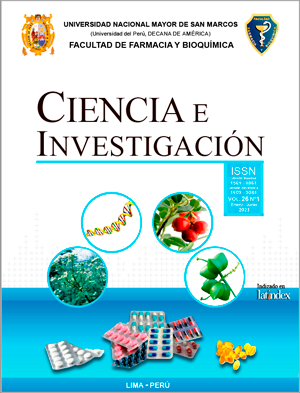Synthesis of Titanium Oxide (IV) dopped with rare earth for the removal of Cyanide
DOI:
https://doi.org/10.15381/ci.v26i1.27485Keywords:
Titanium (IV) oxide, Rare earth, Sol-gel, anatase, cyanideAbstract
This paper presents the synthesis of Titanium (IV) Oxide doped with rare earths for cyanide removal in aqueous systems. The synthesis was carried out by the Sol-gel method from an organic Titanium precursor that allows us to obtain the anatase phase; 4 materials were obtained, one pure and 3 doped with Lantano, Cesium and Europium at 1% molar concentration, respectively. The materials obtained were characterized by x-ray diffraction, x-ray fluorescence, infrared spectroscopy and microscopy. To each material, the percentage of cyanide removal was evaluated by applying a dose of 1 g / L of material to an aqueous solution of 40 mg / L of CN- with the help of a reactor with a UV lamp that favors photocatalysis and continuous flow of the solution during 120 min, the concentration of CN- was determined every 20 min. For this, a UV spectrophotometric method was used, which consisted of reacting the problem solution with sodium picrate to obtain a reddish orange coloration.
After the treatments, it was possible to demonstrate the removal of CN-, being more significant with the TiO2.Ln 1%.
Downloads
Published
Issue
Section
License
Copyright (c) 2023 Ricardo León, Wilson León, Delly San Martin, Sergio Valverde

This work is licensed under a Creative Commons Attribution 4.0 International License.
LOS AUTORES RETIENEN SUS DERECHOS:
- Los autores retienen sus derechos de marca y patente, y tambien sobre cualquier proceso o procedimiento descrito en el artículo.
- Los autores retienen el derecho de compartir, copiar, distribuir, ejecutar y comunicar públicamente el articulo publicado en la Revista Ciencia e Investigación (por ejemplo, colocarlo en un repositorio institucional o publicarlo en un libro), con un reconocimiento de su publicación inicial en la Revista Ciencia e Investigación.
- Los autores retienen el derecho a hacer una posterior publicación de su trabajo, de utilizar el artículo o cualquier parte de aquel (por ejemplo: una compilación de sus trabajos, notas para conferencias, tesis, o para un libro), siempre que indiquen la fuente de publicación (autores del trabajo, revista, volumen, numero y fecha).






